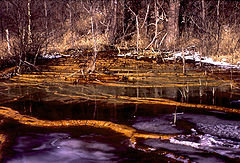Ferrihydrite
| Ferrihydrite | |
|---|---|

Mine drainage from Ohio. The orange coating on the logs is ferrihydrite.
|
|
| General | |
| Category | Oxide minerals |
|
Formula (repeating unit) |
(Fe3+)2O3•0.5H2O |
| Strunz classification | 4.FE.35 |
| Dana classification | 04.03.02.02 |
| Crystal system | Hexagonal |
| Crystal class | Dihexagonal pyramidal (6mm) H-M symbol: (6mm) |
| Space group | P63mc |
| Unit cell | a = 5.958, c = 8.965 [Å]; Z = 1 |
| Identification | |
| Formula mass | 168.70 g/mol |
| Color | Dark brown, yellow-brown |
| Crystal habit | Aggregates, microscopic crystals |
| Streak | Yellow-brown |
| Diaphaneity | Opaque |
| Density | 3.8 g/cm3 |
| References | |
Ferrihydrite (Fh) is a widespread hydrous ferric oxyhydroxide mineral at the Earth's surface, and a likely constituent in extraterrestrial materials. It forms in several types of environments, from freshwater to marine systems, aquifers to hydrothermal hot springs and scales, soils, and areas affected by mining. It can be precipitated directly from oxygenated iron-rich aqueous solutions, or by bacteria either as a result of a metabolic activity or passive sorption of dissolved iron followed by nucleation reactions. Ferrihydrite also occurs in the core of the ferritin protein from many living organisms, for the purpose of intra-cellular iron storage.
Ferrihydrite only exists as a fine grained and highly defective nanomaterial. The powder X-ray diffraction pattern of Fh contains two scattering bands in its most disordered state, and a maximum of six strong lines in its most crystalline state. The principal difference between these two diffraction end-members, commonly named two-line and six-line ferrihydrites, is the size of the constitutive crystallites. The six-line form has been classified as a mineral by the IMA in 1973 with the nominal chemical formula 5Fe2O3•9H2O. However, its formula is fundamentally indeterminate as its water content is variable. The two-line form is also called hydrous ferric oxides (HFO).
Due to the nanoparticulate nature of ferrihydrite, the structure has remained elusive for many years and is still a matter of controversy. Drits et al., using X-ray diffraction data, proposed a multiphase material with three components: defect-free crystallites (f-phase) with double-hexagonal stacking of oxygen and hydroxyl layers (ABAC sequence) and disordered octahedral Fe occupancies, defective crystallites (d-phase) with a short-range feroxyhite-like (δ-FeOOH) structure, and subordinate ultradisperse hematite (α-Fe2O3). Recently, a new single phase model for both ferrihydrite and hydromaghemite has been proposed by Michel et al., based on pair distribution function (PDF) analysis of x-ray total scattering data. The structural model, isostructural with the mineral akdalaite (Al10O14(OH)2), contains 20% tetrahedrally and 80% octahedrally coordinated iron.
...
Wikipedia
